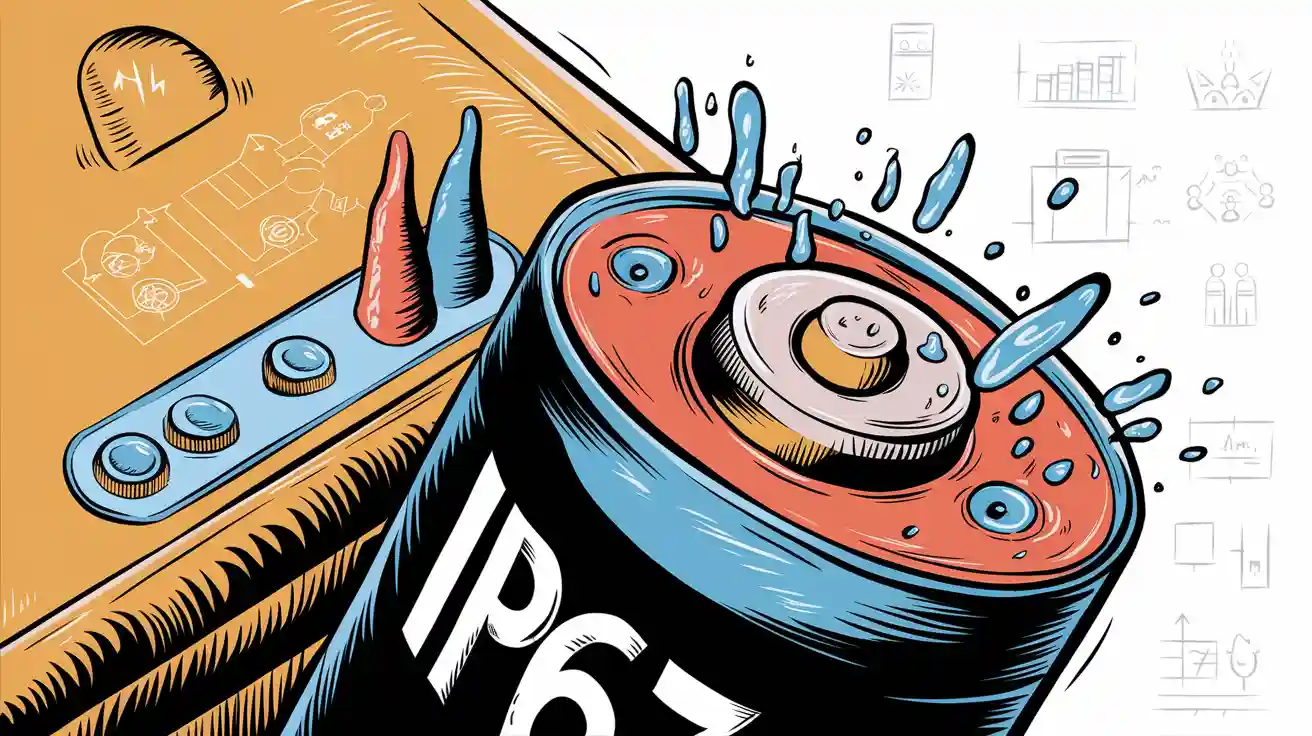
IP ratings for lithium battery packs measure protection against ingress of dust and water, critical for safety in Industrial or Medical settings. The table below summarizes how IP ratings impact battery protection and durability:
Aspect | Explanation |
|---|---|
IP Rating Definition | Measures dust and water resistance of battery casings, standardized by IEC. |
Example IP67 | Dust-tight and water immersion up to 1m for 30 minutes, ensuring high protection level. |
Impact on Safety | Prevents ingress that can cause damage, short circuits, or fire hazards. |
You need reliable ingress protection since lithium-ion batteries must resist harsh conditions. Strong protection extends battery life and reduces failure risk. IP67 remains the industry standard for robust protection in demanding environments.
Key Takeaways
IP ratings show how well lithium battery packs resist dust and water, helping you pick the right protection for your environment.
Choose higher IP ratings like IP67 for outdoor or harsh conditions to keep batteries safe from dust, water, and damage.
Always check that your batteries meet testing and certification standards to ensure reliable performance and safety.
Part 1: IP Ratings for Lithium Battery
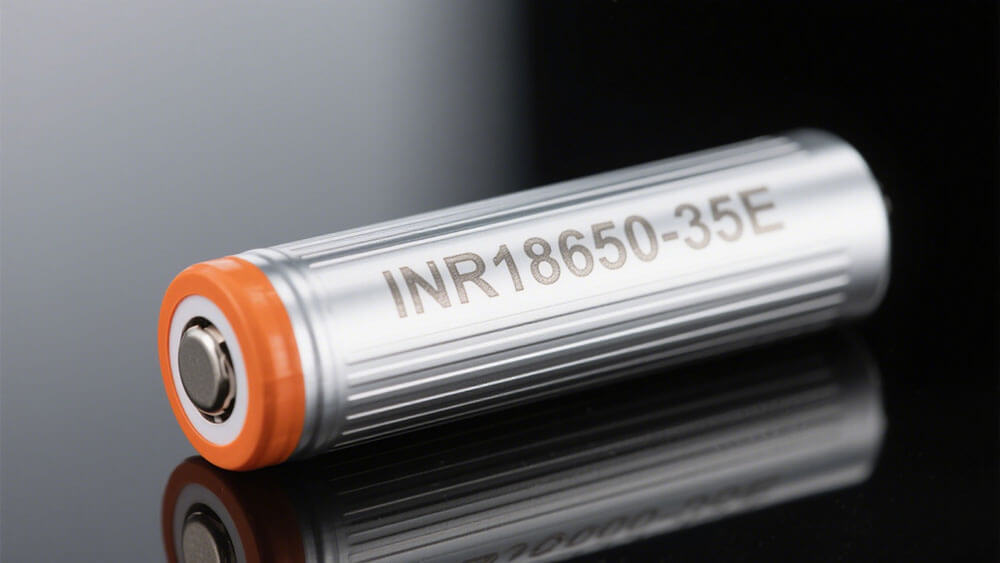
1.1 Ingress Protection Explained
You need to understand how ingress protection (IP) ratings for lithium battery packs safeguard your systems in challenging environments. The IP rating system, established by the International Electrotechnical Commission (IEC) under the IEC 60529 standard, provides a universal method to classify the level of protection that enclosures offer against solids and liquids. This standard replaced vague terms like “waterproof” with a precise, two-digit code, ensuring you can select the right battery IP rating for your application.
Note: The IP code originated in IEC 60529, first published in 1976, and has since become the global benchmark for environmental protection ratings in industrial, medical, and consumer electronics sectors.
The IP ratings for lithium battery packs help you prevent dust, water, and other contaminants from entering the battery enclosure. This protection is critical for lithium-ion batteries, LiFePO4, and other advanced chemistries, as even minor ingress can lead to corrosion, short circuits, or catastrophic failure. You will find that ingress protection is especially important in sectors such as Medical, Robotics, Security, Infrastructure, and Industrial applications, where reliability and safety are non-negotiable. For more on lithium-ion batteries, see Lithium-Ion Battery Technology.
1.2 IP Protection Rating System
The IP protection rating consists of two digits following the letters “IP.” Each digit represents a different type of protection:
The first digit (0-6) indicates the level of protection against solid objects, such as dust or tools.
The second digit (0-9) shows the level of protection from water, including drips, sprays, jets, and immersion.
Here is a breakdown of the IP code structure as defined by IEC 60529:
Digit Position | Meaning | Scale |
|---|---|---|
First Digit | Protection against solid objects and access to hazardous parts | 0 (no protection) to 6 (dust tight) |
Second Digit | Protection against water ingress | 0 (no protection) to 9 (high-pressure, high-temperature water jets) |
You can refer to the following tables for a detailed explanation of each digit:
First Digit (Solids) | Description | Examples |
|---|---|---|
0 | No protection | – |
1 | Protection against objects > 50 mm | Large body parts like back of hand |
2 | Protection against objects > 12.5 mm | Fingers |
3 | Protection against objects > 2.5 mm | Tools, thick wires |
4 | Protection against objects > 1 mm | Most wires, screws |
5 | Dust protected (limited ingress) | Dust does not interfere with operation |
6 | Dust tight | No dust ingress |
Second Digit (Liquids) | Description | Examples/Test Conditions |
|---|---|---|
0 | No protection | – |
1 | Protection against vertically dripping water | Dripping water has no harmful effect |
2 | Protection against dripping water when tilted 15° | Dripping water at angle has no harmful effect |
3 | Protection against spraying water | Spray at angles up to 60° |
4 | Protection against splashing water | Splashing from any direction |
5 | Protection against water jets | Water jets from any direction |
6 | Protection against powerful water jets | More powerful jets |
7 | Protection against temporary immersion | Immersion up to 1 meter |
8 | Protection against continuous immersion | Immersion beyond 1 meter |
9 | Protection against high-pressure, high-temperature water jets | Steam and high-pressure jets |
This system allows you to quickly assess the level of protection a lithium battery enclosure provides. For example, an IP67 rating means the battery is completely dust-tight and can withstand immersion in water up to 1 meter for 30 minutes.
Tip: Always check both digits in the IP protection rating to ensure your battery meets the specific requirements of your application environment.
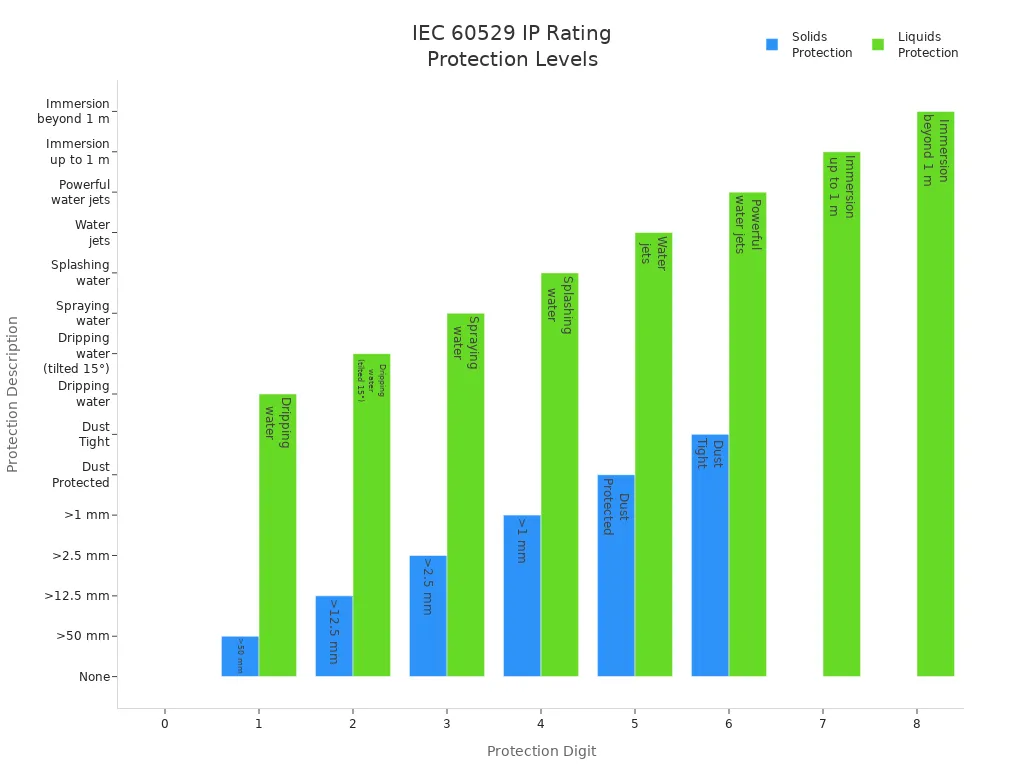
1.3 Common IP Ratings
You will encounter several common IP ratings for lithium battery packs, each offering a different level of protection. The most frequently used ratings include IP20, IP22, IP54, IP65, IP66, IP67, and IP68. Each rating addresses specific operational needs and environmental challenges.
IP Rating | Solid Protection (Dust) | Liquid Protection (Water) | Typical Applications |
|---|---|---|---|
IP20, IP22 | Limited or no dust protection | Splash resistance or indoor use only | Indoor use, office equipment |
IP54 | Limited dust ingress, no harmful effect | Splashing water from any direction | Light industrial, consumer electronics |
IP65 | Dust-tight (no dust ingress) | Resistant to low-pressure water jets | Solar farms, outdoor industrial use |
IP66 | Dust-tight | Resistant to powerful water jets | Marine deck equipment, harsher outdoor conditions |
IP67 | Dust-tight | Submersible up to 1 meter for 30 minutes | Marine applications, flood-prone areas |
IP68 | Dust-tight | Extended submersion (e.g., 3 meters for 1 hour) | Deep-sea, harsh underwater environments |
You should select the appropriate IP ratings for lithium battery packs based on your operational environment:
IP20/IP22: Suitable for indoor use, offering basic protection against dust and dripping water. These ratings are common in office or cabinet installations where exposure to water is minimal.
IP54: Provides moderate protection against dust and splashing water, making it suitable for light industrial or consumer electronics.
IP65: Delivers dust-tight protection and resists water jets, ideal for outdoor use in solar farms or industrial vehicles. The ip65 rating ensures your battery can handle exposure to rain or cleaning processes.
IP66: Offers dust-tight protection and withstands powerful water jets, making it suitable for marine or harsh outdoor environments.
IP67: Ensures complete dust-tightness and temporary immersion in water, which is essential for marine, security, or infrastructure applications. The ip67 rating is often the minimum standard for outdoor or mission-critical systems.
IP68: Provides the highest level of protection, allowing for continuous submersion. This rating is necessary for deep-sea or specialized industrial applications.
IP Rating | Dust Protection Level | Water Protection Level | Real-World Lithium Battery Use Case |
|---|---|---|---|
IP20 | Limited protection; suitable for indoor use only | Minimal water protection; indoor use only | Indoor or cabinet installations; not suitable for outdoor or wet environments |
IP22 | Limited dust protection; indoor use | Protected against dripping water when tilted up to 15° | Indoor use with slight moisture exposure; not for outdoor use |
IP54 | Limited dust ingress, no operational impact | Splashing water from any direction | Light industrial, consumer electronics |
IP65 | Dust tight; full dust protection | Protection against water jets from any direction | Suitable for outdoor use where water jets may occur, e.g., golf carts, forklifts; not submersible |
IP66 | Dust tight; full dust protection | Protection against powerful water jets | Outdoor use with higher water jet exposure; still not for immersion |
IP67 | Dust tight; full dust protection | Protection against temporary immersion up to 1m depth | |
IP68 | Dust tight; full dust protection | Protection against continuous immersion beyond 1m depth | Ideal for harsh outdoor and marine environments requiring continuous water immersion resistance |
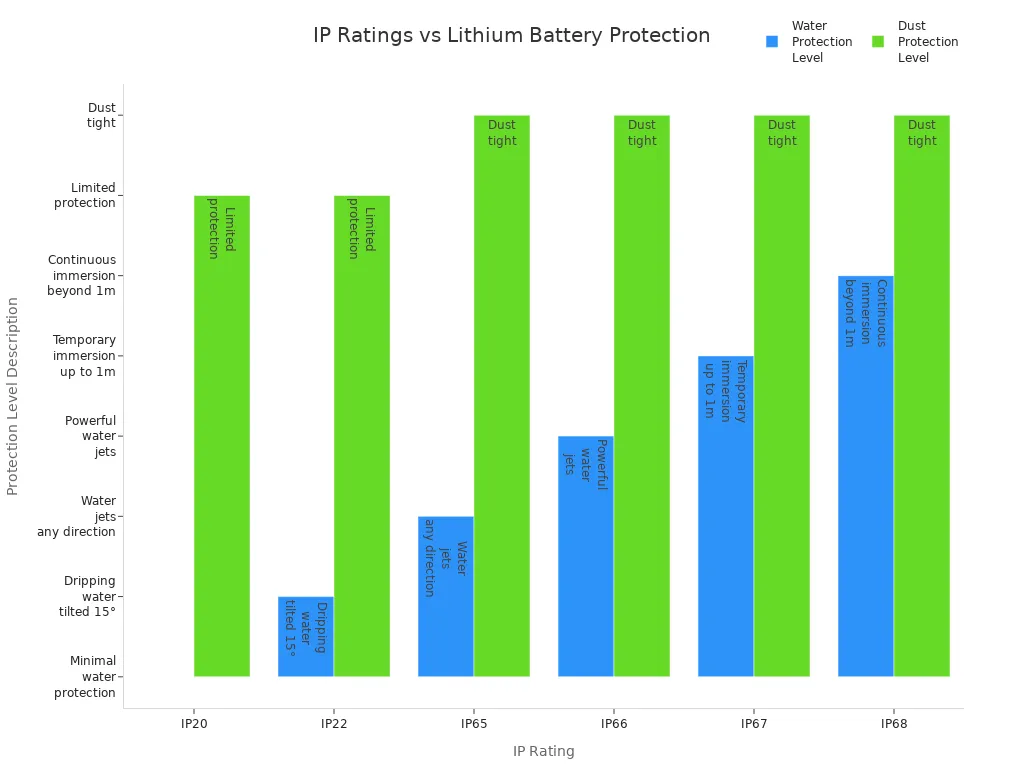
Reminder: Always match the IP protection rating to your specific application. For outdoor or harsh environments, choose IP65 or higher to ensure your lithium batteries remain safe and durable.
Part 2: Choosing the Right IP Rating
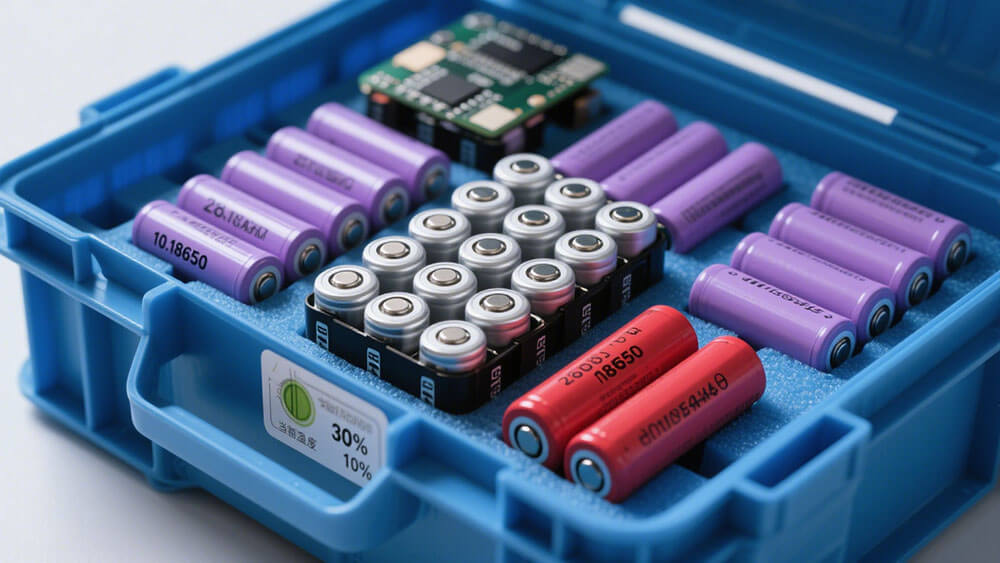
2.1 Application Environments
When you select a lithium battery pack for your business, you must evaluate the environment in which the battery will operate. The right protection level depends on exposure to dust, water, humidity, and corrosive substances. You should consider the following environmental factors:
Dust exposure: Warehouses, manufacturing floors, and outdoor sites often have airborne particles that can penetrate battery enclosures.
Humidity and wetness: High humidity accelerates corrosion and can degrade battery components.
Corrosive contaminants: Marine environments introduce saltwater, which is highly corrosive to battery terminals and enclosures.
Mechanical stress: Industrial forklifts, robotics, and infrastructure systems face vibration and impact, which can compromise seals.
Indoor environments, such as offices or medical facilities, typically require lower IP ratings like IP20 or IP22. These ratings provide basic protection against dust and minimal water ingress. In contrast, outdoor, marine, and industrial applications demand robust protection. For example, industrial forklift lithium battery packs used in logistics or manufacturing must withstand dust, water jets, and frequent cleaning. Marine electronics and infrastructure deployments require protection against saltwater and continuous moisture.
Tip: Always match the IP rating to the specific risks in your application. Over-specifying protection increases cost and weight, while under-specifying exposes your battery to failure.
2.2 IP67 and Outdoor Use
You should prioritize IP67 when choosing a lithium battery for outdoor or harsh environments. The IP67 rating guarantees total dust-tight protection and safeguards the battery against immersion in water up to 1 meter for 30 minutes. This level of protection is necessary for outdoor conditions, where dust, humidity, rain, and accidental submersion are common.
Lower ratings, such as IP65 rating or IP66, offer resistance to water jets but do not ensure protection against immersion. Lithium batteries have vulnerable points, including vents for cooling and gas release, which can allow moisture and dust ingress. This can lead to corrosion, short circuits, overheating, or fire. Industry standards and manufacturers recommend IP67 or higher for outdoor, automotive, marine, and camping applications.
IP67-rated batteries, such as LiFePO4 models, are designed to resist moisture, dust, and saltwater corrosion. These batteries deliver long cycle life, often exceeding 4000 cycles, and maintain performance even with full depth of discharge. Manufacturers use corrosion-resistant materials and advanced sealing to prevent moisture ingress while allowing necessary cooling and gas release.
IP Rating | Dust Protection Level | Water Protection Level | Typical Applications |
|---|---|---|---|
IP65 | Complete dust-tight | Resistant to low-pressure water jets | Outdoor lighting, streetlights, forklift |
IP67 | Total dust-tight | Temporary submersion up to 1 meter for 30 minutes | Wet environments, docks, marine, forklift |
IP68 | Total dust-tight | Continuous immersion under severe conditions | Extreme wet environments, agricultural machinery, forklift |
IP69K | Total dust-tight | High-pressure, high-temperature water jets | Food processing, hygiene-sensitive areas, forklift |
You reduce risks of corrosion, short-circuiting, and performance degradation by using IP67-rated batteries in outdoor and marine environments. However, you should avoid prolonged exposure beyond the IP67 limits, such as deeper or longer immersion, to prevent damage.
Note: Many warranty and service agreements specify environmental limits based on IP ratings. Exceeding these limits, such as submerging a battery beyond its rated protection, may void warranty coverage.
2.3 Testing and Certification
You must ensure that your lithium battery packs meet rigorous testing and certification standards to guarantee protection and reliability. The primary standard for IP ratings is IEC 60529, which defines ingress protection levels against dust and water. Testing procedures include:
Dust testing in sand or dust chambers, following standards like GB/T 2423.37.
Water testing with spray nozzles and immersion tanks, as specified in GB/T 4208-2017.
Certification for compliance with regional or international regulations, such as CE or UL.
IP ratings consist of two digits: the first for dust protection (0-6), the second for water resistance (0-9).
You select the appropriate IP rating based on the intended environment—IP20–IP54 for indoor use, IP65 or higher for outdoor or humid environments, and IP67/IP68 for extreme conditions like marine use.
Lithium batteries must also pass safety and transport tests under the UN 38.3 standard, which includes altitude simulation, thermal cycling, vibration, shock, external short circuit, impact/crush, overcharge, and forced discharge. These tests simulate hazards such as low pressure, temperature extremes, mechanical stress, and electrical faults. Compliance is mandatory for classification and certification.
Certifications like UL 2271 and UL 1973 set quality standards for battery systems, requiring third-party testing and verification. These certifications validate the reliability of IP ratings and build confidence in battery protection against environmental and operational stresses. For critical infrastructure, you must comply with IEC 60529, UL 1973, UL 1642, and UN transport regulations. These standards ensure safe deployment and operation in government, utility-scale, and industrial applications.
Recent technological advancements have improved ingress protection for lithium battery enclosures. Manufacturers use multi-objective optimization and Finite Element Analysis to enhance structural strength and durability. Advanced sealing techniques, integration of sensors for real-time monitoring, and manufacturing methods like aluminum extrusion and die-casting produce lightweight, corrosion-resistant enclosures with complex shapes that improve sealing and protection.
Alert: Always verify that your battery packs have passed all required tests and certifications before deployment. This ensures compliance with industry standards and protects your investment.
You gain a clear advantage by understanding the significance of IP ratings when selecting lithium battery packs for demanding environments. Higher ingress protection, such as IP67, shields your battery from dust and water, extending service life and improving safety. Assess your application needs, consult with experts, and regularly review your battery systems to ensure optimal protection.
FAQ
1. What does IP67 mean for a lithium battery pack in industrial applications?
IP67 ensures your battery remains dust-tight and resists immersion in water up to 1 meter for 30 minutes. This rating supports reliable operation in harsh industrial environments.
2. How do you select the right IP rating for Medical or Robotics battery packs?
You assess exposure risks in your application. For Medical or Robotics, choose IP65 or higher for enhanced safety and durability.
3. Where can you consult for custom lithium battery solutions with certified IP ratings?
You contact Large Power for tailored lithium battery packs and expert guidance. Visit the custom battery consultation page for support.




